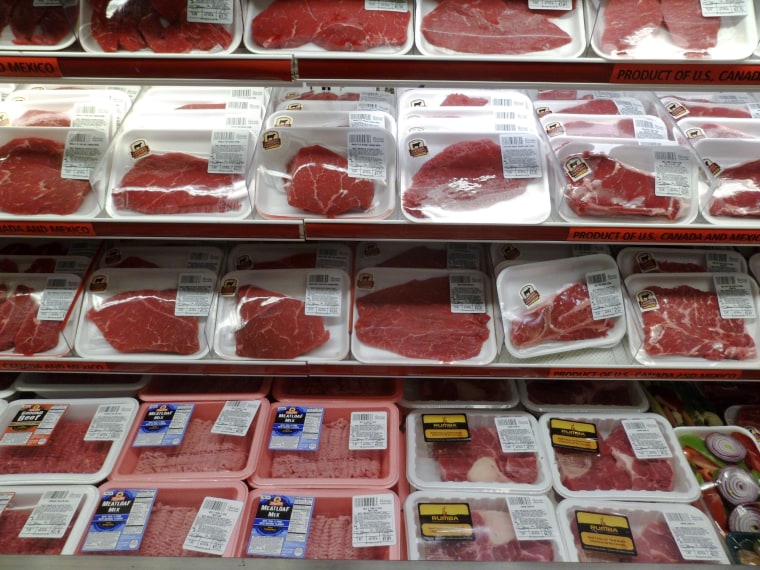Contaminated beef makes 333 people sick. Kosher poultry carrying Salmonella kills one person and puts 11 into the hospital. And, perhaps most startling, federal health officials tell Americans to stop eating all romaine lettuce because of an outbreak of E. coli.
If it seems like there are more food recalls lately, it’s because there are. And a new report Thursday from the Public Interest Research Group argues that federal health officials can and should be doing more to protect the U.S. food supply.
“These recalls are a warning to everyone that something is rotten in our fields and slaughterhouses. Government agencies need to make sure that the food that reaches people’s mouths won’t make them sick,” said Adam Garber, the group's consumer watchdog.
PIRG found a 10 percent increase in food recalls of all types between 2013 and 2018 across the U.S. Broken down by food type, there was a 67 percent increase in meat and poultry recalls and a 2 percent rise in produce and processed food recalls, according to the group’s analysis of federal government data.
And while the government says the U.S. food supply is very safe, the consumer group says it could be safer.
“There are systemic failures in the food system, which means that we are still rolling the dice when we go food shopping,” PIRG’S Viveth Karthikeyan, who worked on the report, told NBC News.
“Americans should be confident that their food is safe and uncontaminated.”
The Food and Drug Administration and the Centers for Disease Control and Prevention argue that much of the increase in recalls is due to better detection and monitoring. Genetic fingerprinting means that what looked like many unrelated cases of illness can now be traced to a common source, and that can prompt a recall that protects thousands more.
“We do agree that some of the recalls are due to the government being better at monitoring and surveillance,” Karthikeyan said. But he said the government has not implemented rules that would make food even safer, and retailers are not doing enough to make sure customers learn quickly about recalls.
Other groups have made similar complaints. Earlier this month, the Pew Trusts' Sandra Eskin said the two recalls of romaine lettuce this year demonstrated that FDA needs to move quickly to implement rules about testing water for contamination.
Some of the beefs that PIRG has with the food safety system:
- Meat production is largely self-regulated
- Produce growers are not required to check their irrigation water for bacteria
- Food producers or retailers are not punished for repeat offenses
- There’s no coherent system for warning people they may have purchased contaminated food
The U.S. Department of Agriculture oversees the safety of meat and poultry, and tells consumers to expect that chicken carcasses, for instance, are likely to carry salmonella. That’s why people are warned against allowing raw meat to touch anything that might go straight to a person’s mouth, and that’s why there are so many guidelines about cooking food to germ-killing temperatures.
“The USDA went so far as to call feces contaminating animals a ‘cosmetic blemish’, allowing the livestock to be processed after rinsing off the offending matter,” the report reads.
Karthikeyan agrees that it’s not reasonable to expect food to be sterile, but the groups would like to see policies in place that at least state that bacterial contamination is undesirable.
Another problem area is factory farms. “Concentrated Animal Feeding Operations, also known as factory farms, are sometimes a conduit for contamination of meat because overcrowded conditions mean that when one animal gets sick, they pass the disease on to other animals,” the group said.
Not only does meat get contaminated, but the manure from intensively farmed animals gets onto nearby fields and into water supplies. That may have been the source of outbreaks of E. coli that forced several recalls of salad greens in recent years, including two romaine lettuce recalls.
The 2011 Food Safety Modernization Act directed FDA to reform its food safety regulations. The agency issued a final rule in 2015 that gave growers until early this year, rolling into 2022, to test water quality. But the FDA delayed implementing the rule last year.
"FDA must end these delays and promptly finish any revisions to the initial water standard," Pew's Eskin said.
Also last year, FDA Commissioner Dr. Scott Gottlieb said he was having the agency investigate better ways to use technology to monitor food from farm to table so that outbreaks don’t take weeks or months to trace. The PIRG report supports this and urges FDA to move quickly.
“It could take weeks to locate the source of an outbreak in something like fruit and vegetables by which time dozens of people could have gotten sick because the food is perishable,” the report reads.
“Delays risk serious health consequences and point to the need to streamline the process of agriculture supply chain transparency.”
Even when the food is not perishable, it can take weeks and months to recall. Honey Smacks cereal was recalled last June, but the CDC kept finding affected product on store shelves well into the fall.
“When risky products make it to stores, we need to ensure that removing products from shelves, company stocks, and consumers’ homes happens completely and at lightning speed,” the report reads.
Contaminated food is an extremely common problem. The CDC estimates that germs in food make 48 million Americans sick every year — that’s one out of six people. About 128,000 are made sick enough to be hospitalized, and 3,000 die.





